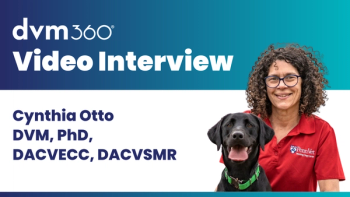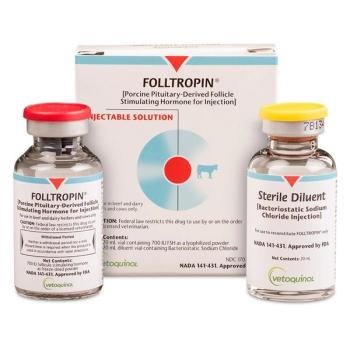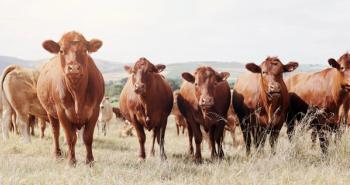
- dvm360 April 2022
- Volume 53
- Issue 4
The 80 year-old man
How a cowboy with cancer and his horse with a leg injury made me realize why I became a vet
They told us somewhere, in some class, in veterinary school that we all had a reason we wanted to practice veterinary medicine, that it was different for each of us, and that it would change as we matured in our career. They also said that by the end of our career, it would be obvious, as we looked back over the years, just what it was that we used as a motif.
They said for some of us it would be money, for others fame, or the challenge of medicine and surgery, or compassion for animals, or the effect on owners whose animals we care for. But for most of us, it would be a combination of all these things with an emphasis on one or two.
I have watched 27 years of practice pass by and wondered several times where I fit into this list. Most veterinarians have a compassion for animals—so I think that one is a given—but what has kept me going for all that time? One case best describes why I love this job so much.
Benny was an 80-year-old man that I had never met before. He stood before me with a 20-year-old gelding that had a seriously damaged left hock. All the skin was gone over the dorsal side of that area of the leg and the joint was open and contaminated. The gentle old gelding stood on the other 3 legs with both ears hanging low and a sad expression in his eyes.
“That is a terrible injury, sir. I am afraid that joint is badly infected, and it looks like it has been injured a few days already. There is dirt in the joint and no living skin left to suture. I am not sure how effective treatment is going to be, and it could sure run into a lot of money and still not save your horse,” I said with as much compassion and realism as I could muster.
One of the things you might not consider unless you are a veterinarian is the dilemma we face every time we are confronted with a situation like this. I had no idea if this man had the finances available for an undertaking like this, and I didn’t want to see the horse suffer if the client could not pursue the aggressive treatment that was going to be necessary to even have a chance of fixing this mess. If I place too much emphasis on the money, I look like I am just in it for the financial gain and not the best interest of the animal.
“What are you saying veterinary man? I drove 100 miles to get this horse here to you and I didn’t come all that way for a pessimist to tell me it can’t be fixed. I was hoping I had come to a place that had a staff with some confidence and know-how, but it appears I was wrong. I am an old man, and that horse is my best friend. Now fix him and I’ll be back to get him in a couple of weeks when he is well,” the man said in a tone that was somewhere between hateful and angry.
I stood with the intern as Benny glared at us for a minute from underneath the brim of his cowboy hat, ambled to his truck, got in, and drove away. I wondered if that guy had ever smiled even once in his life, as the truck disappeared down the road.
“Do you think there is any chance of fixing this horse?” the intern asked.
“It is bad. I have never seen a joint that messed up get happy, but let’s give it a try,” I replied.
“That old dude has no idea how messed up that leg is,” the intern said. “He seems to think it will just be a couple of weeks of hydrotherapy and then he is going to be rounding up cattle again. You know how much medicine, bandages, pain killers, lab tests, joint lavages, limb perfusions, surgeries, and time it is going to take to even have a 10% chance that that horse will be ridden again? That will cost the clinic thousands of dollars’ worth of just material, not to mention all the time and help it is going to require. You didn’t even tell him how much it will cost, and he never even asked. Usually when people don’t ask, it means they don’t intend on paying…. You gonna do it?”
“I bet he’ll pay,” I replied. “Get started on it. I don’t think he is as grumpy as he puts on.”
We went to work. It was a tough case with many places for failure to occur. We were about 4 days into treatment when the old man’s adult grandson showed up at the clinic. He was a kind man with a sincere expression and had seen the injury prior to the old man bringing the horse and realized how bad it was.
He told us all about it. Not the injury, but the story of the old man. The old cowboy had cancer. It was diagnosed about 3 months ago and it was not a good kind. That horse was his best friend, and he rode it ever day to check cattle in his pastures. It was the only horse he trusted enough to ride, and at age 80, getting pitched off could be deadly. Everyone in the county had offered to let him have a gentle gelding to substitute, but he told them that if he couldn’t ride his horse, he wasn’t going to ride at all.
The grandson went on to say that Benny was going to be in cancer therapy and surgery for the next 3 months. If we could get that horse fixed and ready to ride by the time they released Benny, it would be better therapy than all the medicine every hospital in the world had to offer.
Luck was on our side. We worked hard and that horse was a great patient. In 3 months, the leg had progressed to a point of healing that was far beyond what I had even hoped for. But we had not heard a word from the old cowboy. He would not answer his phone, and we didn’t have the grandson’s number. I wanted to tell him the good news and maybe give him a little hope, but I had no way of getting in touch with him.
One morning I got to work, and the grandson was in the parking lot with a trailer. I hadn’t heard from these people in 3 months and, for all they knew, the horse had died or gotten worse. And for all we knew, the old man had gotten sicker (or even worse). But here the grandson was, walking across the parking lot with a halter, ready to take ole’ grey home.
Two days later, I got a message on Facebook from the grandson. It was a photo of Benny with a glowing smile, gathering a pasture of cows on that horse. The caption was simple: “Thank you doc. You made one old man happy again! First time he has smiled in half a year.”
After 27 years, I know the reason I do this every day. Yes, it is to help that horse and every one like him that comes in. Yes, it is to make money and take care of the people who work with me and my family. Yes, it is to have some notoriety and face the challenges of hard cases. But, that story may be my true motif. There is just nothing better than watching people smile because some horse, dog, cat or other critter is still in their life, and we had something to do with keeping it that way.
Articles in this issue
over 3 years ago
Identifying malignant oral tumorsover 3 years ago
Stronger Togetherover 3 years ago
Practice management software: is your head in the clouds?over 3 years ago
Debate continues over CBD therapyover 3 years ago
Success is in the details when transporting heartworm+ dogsover 3 years ago
Counseling clients on pediatric nutritionalmost 4 years ago
A clinical approach to feline atopic dermatitisNewsletter
From exam room tips to practice management insights, get trusted veterinary news delivered straight to your inbox—subscribe to dvm360.






